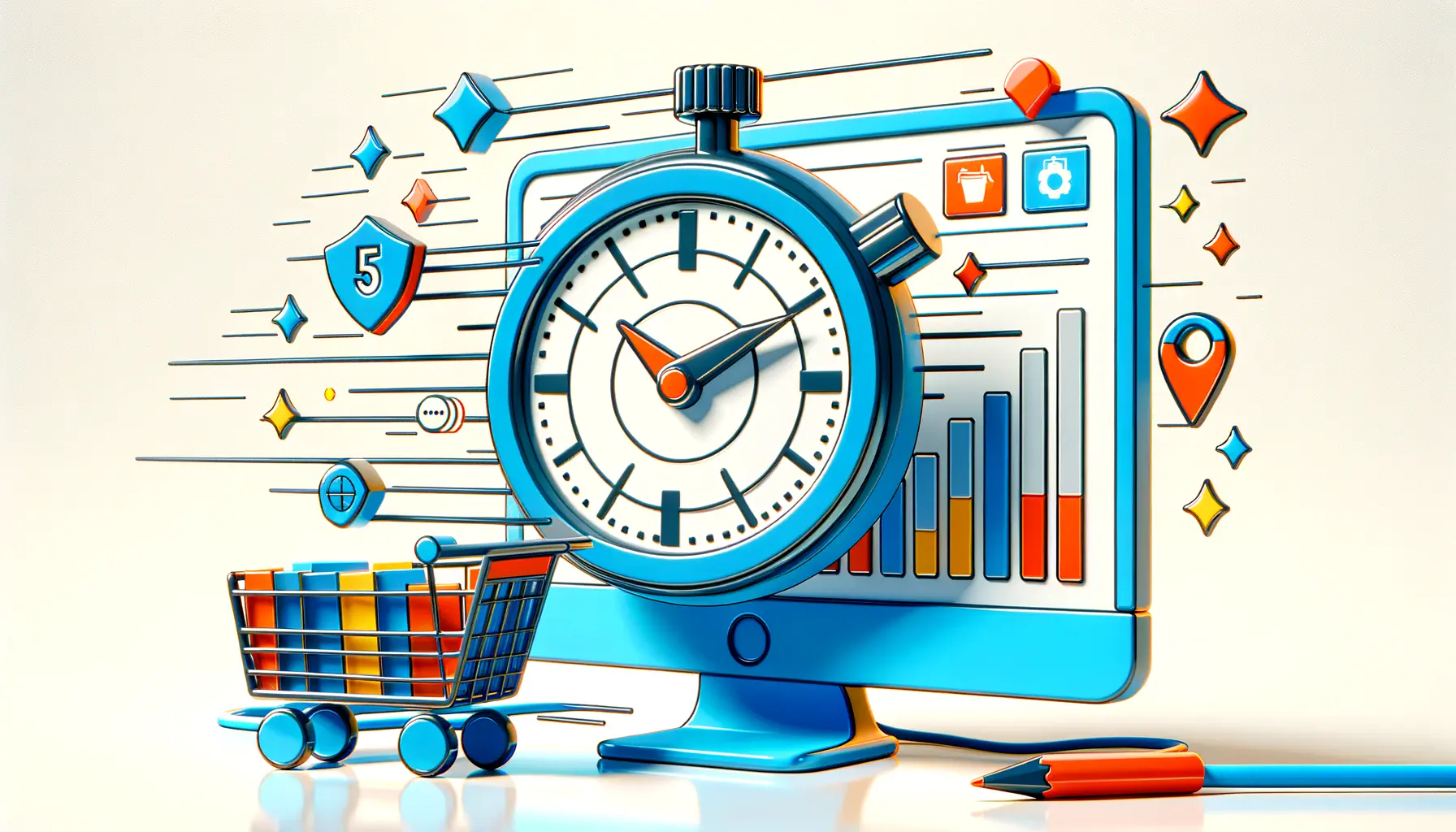In today’s fast-paced digital marketplace, the speed of your online store is not just an operational concern but a critical business strategy.
The connection between website speed and customer satisfaction is undeniable, with numerous studies showing that even a one-second delay in page load time can significantly impact conversion rates, bounce rates, and overall user experience.
As we delve into the realm of speed optimization for online stores, it’s essential to understand that this is not merely about technical adjustments but about enhancing the customer journey, ensuring that every click brings them closer to the products they desire without any waiting frustration.
Speed optimization encompasses a variety of strategies, from the initial design and development phases to ongoing maintenance and updates.
It’s a multifaceted approach that requires attention to detail, a deep understanding of web technologies, and a commitment to providing the best possible experience for your customers.
In this comprehensive guide, we will explore the key aspects of speed optimization, offering actionable insights and techniques that can be applied to any online retail platform.
By focusing on speed, you’re not just improving a website’s performance metrics; you’re elevating the entire brand experience in the eyes of your consumers.
- Understanding the Importance of Speed
- Strategies for Speed Optimization
- Enhancing User Experience Through Speed
- Advanced Speed Optimization Techniques
- Measuring and Monitoring Website Speed
- SEO Implications of Website Speed
- Future Trends in Speed Optimization
- Conclusion: The Road to Speedier Online Stores
- FAQs on Speed Optimization for Online Stores
Understanding the Importance of Speed
Why Speed Matters in Online Retail
The significance of speed in the online retail sector cannot be overstated.
In an era where consumers expect instant gratification, a slow-loading website can be the difference between a completed sale and a lost customer.
Speed affects not only user satisfaction but also search engine rankings, with faster sites receiving preferential treatment in search results.
This direct link between site speed, user experience, and SEO performance highlights the necessity for speed optimization as a core component of any online retail strategy.
Moreover, the impact of speed extends beyond the digital realm, influencing brand perception and customer loyalty.
A fast, efficient website reflects a company’s commitment to quality and respect for the customer’s time, thereby fostering trust and encouraging repeat business.
In contrast, a slow site can frustrate users, damage brand reputation, and lead to higher abandonment rates.
Thus, investing in speed optimization is not just a technical endeavor but a strategic move towards building a strong, customer-centric online presence.
Key Factors Affecting Website Speed
Several technical elements play a crucial role in determining the speed of an online store.
These include web hosting quality, the size and format of images and videos, the efficiency of the site’s code, and the use of content delivery networks (CDNs).
Additionally, third-party scripts for analytics, social media integration, and other features can significantly impact load times.
Understanding these factors is the first step in diagnosing and improving the performance of an online retail site.
To effectively address these issues, retailers must conduct regular site audits, identify bottlenecks, and implement targeted optimizations.
This might involve upgrading hosting solutions, optimizing media files, minifying CSS and JavaScript files, and leveraging browser caching.
Each of these actions can contribute to a noticeable improvement in site speed, enhancing the overall user experience and supporting business objectives.
Optimizing the speed of your online store is a continuous process that requires regular monitoring and adjustments to keep pace with technological advancements and changing consumer expectations.
Strategies for Speed Optimization
Optimizing the speed of an online store involves a comprehensive approach that touches on various aspects of web development and design.
By implementing a series of targeted strategies, retailers can significantly reduce load times, improve user engagement, and boost conversion rates.
Below, we outline some of the most effective techniques for enhancing the performance of your online retail site.
Choosing the Right Hosting Solution
The foundation of any fast-loading website is a robust and reliable hosting service.
The choice of hosting can dramatically affect your site’s speed, with dedicated servers and cloud hosting options generally offering better performance than shared hosting plans.
When selecting a hosting provider, consider factors such as server location, resource allocation, and scalability options to ensure that your hosting solution can support your site’s traffic and speed requirements.
- Server Location: Choose a server location close to your primary audience to reduce latency.
- Resource Allocation: Ensure that your hosting plan provides sufficient resources (CPU, RAM) to handle your site’s load efficiently.
- Scalability: Opt for a hosting solution that allows you to easily scale resources up or down based on traffic fluctuations.
Optimizing Images and Media Files
Large images and media files are among the top culprits for slow website performance.
Optimizing these elements can lead to significant speed improvements.
This process includes compressing images, using the correct file formats, and implementing lazy loading techniques to delay the loading of images and videos until they are actually needed.
- Image Compression: Use tools to reduce the file size of images without sacrificing quality.
- Correct File Formats: Choose the most efficient file format for each type of media (e.g., JPEG for photos, PNG for graphics).
- Lazy Loading: Implement lazy loading to prevent offscreen images from being loaded until the user scrolls to them.
Minifying Code and Leveraging Browser Caching
Excess or inefficient code can slow down your website.
Minifying CSS, JavaScript, and HTML files by removing unnecessary characters without changing their functionality can help speed up load times.
Additionally, leveraging browser caching allows frequently accessed resources to be stored locally in the user’s browser, reducing the need to reload them on subsequent visits.
- Code Minification: Utilize tools to remove whitespace, comments, and unnecessary characters from code.
- Browser Caching: Configure your server to set appropriate expiry times for resources, enabling browsers to cache these resources effectively.
While these strategies are crucial for speed optimization, it’s important to regularly test and monitor your site’s performance to identify areas for improvement and ensure that your optimization efforts are delivering the desired results.
Enhancing User Experience Through Speed
At the heart of speed optimization efforts is the goal to enhance the overall user experience (UX) on your online store.
A fast-loading website not only satisfies the immediate need for speed but also contributes to a smoother, more enjoyable browsing and shopping experience.
This section explores how optimizing speed can directly impact various aspects of UX and outlines strategies to ensure your site remains user-friendly and efficient.
Improving site speed is intrinsically linked to better user engagement metrics, such as lower bounce rates, longer session durations, and higher conversion rates.
Users are more likely to browse through a fast-loading site, explore more products, and complete purchases without frustration.
Here are key areas where speed optimization intersects with UX enhancements:
- First Impressions: The initial loading time of your site sets the tone for the user’s experience. A fast load time creates a positive first impression, signaling efficiency and reliability.
- Navigation and Interaction: A responsive site enables smoother navigation and interaction, allowing users to quickly find what they’re looking for without delays.
- Checkout Process: Speed optimization is crucial for the checkout process, where any delay can lead to cart abandonment and lost sales.
Implementing Responsive Design
A responsive website design ensures that your online store looks and performs well across all devices, from desktops to smartphones.
With mobile commerce growing rapidly, optimizing for mobile speed is essential.
Responsive design adapts to the user’s device, providing a seamless experience without requiring separate versions of your site for different devices.
- Mobile Optimization: Focus on optimizing elements that impact mobile speed, such as image sizes and touch interactions.
- Testing on Multiple Devices: Regularly test your site’s performance across a range of devices to ensure consistent speed and usability.
Streamlining the Checkout Process
One of the most critical aspects of the user experience is the checkout process.
A fast and efficient checkout can significantly increase conversion rates.
Simplifying the checkout process, reducing the number of steps, and ensuring that pages load quickly will keep customers engaged and reduce the likelihood of cart abandonment.
- Simplified Forms: Minimize the number of fields in checkout forms to speed up the process.
- Guest Checkout Option: Offer a guest checkout option to eliminate the need for account creation, speeding up the purchase process for new customers.
Enhancing the speed of your online store is not just about improving technical performance; it’s about creating a more enjoyable, frictionless shopping experience that encourages customers to return.
Advanced Speed Optimization Techniques
For online retailers looking to push the boundaries of website performance, advanced speed optimization techniques offer the next level of enhancements.
These methods go beyond basic optimizations, delving into the more technical aspects of web development and infrastructure.
They are designed to squeeze every millisecond of speed from your site, providing a competitive edge in the fast-paced world of online retail.
Implementing these advanced strategies requires a deeper understanding of web technologies and possibly the assistance of experienced web developers.
However, the investment can lead to substantial improvements in site speed, user experience, and ultimately, business outcomes.
Let’s explore some of the most impactful advanced techniques.
Content Delivery Network (CDN) Usage
A Content Delivery Network (CDN) is a network of servers distributed globally, designed to deliver content to users more efficiently based on their geographic location.
By caching content on multiple servers around the world, a CDN can significantly reduce the time it takes for data to travel between the server and the user, thereby improving site speed for a global audience.
- Global Reach: CDNs are especially beneficial for online stores with an international customer base, ensuring fast load times worldwide.
- Scalability: CDNs can handle sudden spikes in traffic, providing stability during peak shopping periods.
Advanced Caching Strategies
Caching is a technique that stores copies of files in a temporary storage location so they can be accessed more quickly.
Advanced caching strategies involve fine-tuning cache settings for different types of content, implementing server-side caching, and utilizing browser caching to its fullest potential.
These strategies can dramatically reduce load times by ensuring that only new or changed content is loaded on subsequent visits.
- Server-Side Caching: Store fully rendered pages on the server to be delivered quickly upon request, without the need for database queries or template rendering.
- Browser Caching Optimization: Customize cache-control headers to optimize how resources are cached by the browser.
Database Optimization
For online stores powered by content management systems (CMS) or e-commerce platforms, database performance is a critical factor in site speed.
Optimizing the database involves regular maintenance tasks such as cleaning up old data, optimizing queries, and ensuring that the database is properly indexed.
These actions can help reduce the time it takes to retrieve data, improving the speed of dynamic content generation.
- Data Cleanup: Regularly remove unnecessary data from your database to keep it running efficiently.
- Query Optimization: Ensure that database queries are as efficient as possible to reduce load times for pages that pull data from the database.
Advanced speed optimization techniques offer significant benefits but require a higher level of technical expertise. The investment in these strategies pays off through improved site performance, enhanced user satisfaction, and increased conversion rates.
Measuring and Monitoring Website Speed
Understanding the current performance of your online store is crucial before implementing any speed optimization strategies.
Measuring and monitoring website speed allows you to identify areas for improvement, track the effectiveness of your optimization efforts, and make data-driven decisions.
This section covers the tools and metrics essential for assessing website speed and how to interpret the data they provide.
Several tools are available for measuring website speed, each offering different insights into how your site performs under various conditions.
These tools analyze your website’s load time, identify bottlenecks, and provide recommendations for improvement.
Utilizing a combination of these tools can give you a comprehensive view of your site’s speed performance.
Popular Tools for Speed Testing
Google PageSpeed Insights, GTmetrix, and WebPageTest are among the most widely used tools for website speed testing.
They evaluate your site against best practices for performance optimization and provide scores along with actionable suggestions.
These tools can simulate different devices and network conditions, giving you a clearer understanding of your site’s performance across various user scenarios.
- Google PageSpeed Insights: Offers detailed recommendations based on the Core Web Vitals, focusing on loading, interactivity, and visual stability.
- GTmetrix: Provides insights into your site’s performance and structure, offering both PageSpeed and YSlow scores.
- WebPageTest: Allows for more detailed testing with customizable settings for device, browser, and connection speed.
Key Performance Metrics
When analyzing your website’s speed, several metrics are particularly important.
These include First Contentful Paint (FCP), Largest Contentful Paint (LCP), Time to Interactive (TTI), and Total Blocking Time (TBT).
Understanding these metrics can help you pinpoint specific issues affecting your site’s speed and user experience.
- First Contentful Paint (FCP): Measures the time from navigation to the moment when the browser renders the first bit of content from the DOM.
- Largest Contentful Paint (LCP): Measures the time to render the largest content element visible in the viewport, an important metric for understanding perceived load speed.
- Time to Interactive (TTI): Measures the time until the page is fully interactive.
- Total Blocking Time (TBT): Measures the total amount of time that the main thread was blocked, preventing user input responsiveness.
Regularly measuring and monitoring your website’s speed is essential for maintaining optimal performance. By focusing on key metrics and utilizing a variety of tools, you can ensure that your online store offers a fast, efficient, and enjoyable shopping experience.
SEO Implications of Website Speed
The speed of your online store doesn’t just affect user experience; it also has significant implications for search engine optimization (SEO).
Search engines like Google have explicitly stated that site speed is a ranking factor, meaning faster websites are more likely to rank higher in search results.
This section explores the relationship between website speed and SEO, highlighting why speed optimization should be a key component of your SEO strategy.
Improving your website’s speed can lead to better visibility in search engines, attracting more organic traffic to your site.
However, understanding the SEO benefits of speed optimization requires a grasp of how search engines evaluate site performance and the impact of speed on user engagement metrics that influence SEO rankings.
Speed as a Ranking Factor
Google and other search engines aim to provide the best possible experience for their users, which includes directing them to websites that load quickly and efficiently.
A fast-loading site is seen as a marker of quality and reliability, factors that search engines reward with higher rankings.
This is particularly true since the introduction of mobile-first indexing, where the mobile version of your site is the primary version considered for indexing and ranking.
- Mobile-First Indexing: With the majority of web traffic now coming from mobile devices, ensuring your site is optimized for mobile speed is crucial for SEO.
- User Engagement: Speed impacts bounce rates, time on site, and other engagement metrics that search engines use to assess the quality of a website.
Optimizing for Core Web Vitals
In recent years, Google has introduced Core Web Vitals as part of its page experience signals used for ranking websites.
These metrics measure the speed, responsiveness, and visual stability of a page, providing a clear framework for optimizing site performance in relation to SEO.
- Largest Contentful Paint (LCP): Aims for a fast loading experience, with a target of 2.5 seconds or faster.
- First Input Delay (FID): Measures interactivity and responsiveness, with a target of less than 100 milliseconds.
- Cumulative Layout Shift (CLS): Measures visual stability, with a target of less than 0.1.
By focusing on these Core Web Vitals, along with other speed optimization strategies, you can improve your site’s SEO performance, leading to higher rankings, more traffic, and ultimately, increased sales.
It’s a clear indication that speed optimization is not just a technical concern but a crucial aspect of your overall digital marketing strategy.
Neglecting website speed can have detrimental effects on your SEO efforts, reducing visibility in search engine results and impacting your ability to attract and retain visitors.
Future Trends in Speed Optimization
The landscape of web development and online retail is constantly evolving, with new technologies and optimization techniques emerging regularly.
Staying ahead of these trends is crucial for maintaining a competitive edge in the digital marketplace.
This section looks forward to the future of speed optimization, highlighting emerging technologies and practices that could shape the next generation of fast, efficient online stores.
As internet speeds increase and consumer expectations rise, the focus on website speed optimization is more critical than ever.
The future of speed optimization lies in adopting new technologies, optimizing for the latest web standards, and continuously refining your approach to meet the changing demands of users and search engines alike.
Emerging Technologies and Practices
Several emerging technologies and practices are set to influence the future of speed optimization in online retail.
These include the adoption of next-generation image formats, the increased use of progressive web apps (PWAs), and the implementation of edge computing to reduce latency.
- Next-Generation Image Formats: Formats like WebP and AVIF offer superior compression and quality compared to traditional formats, leading to faster load times.
- Progressive Web Apps (PWAs): PWAs provide a native app-like experience on the web, leveraging service workers for offline support and fast loading.
- Edge Computing: By processing data closer to the user, edge computing reduces latency and speeds up content delivery, enhancing the user experience.
Optimizing for New Web Standards
The web is governed by standards that evolve over time, and keeping up with these changes is essential for speed optimization.
Future standards will likely emphasize performance, accessibility, and security, requiring online retailers to adapt their optimization strategies accordingly.
Staying informed about developments in HTML, CSS, JavaScript, and other core technologies will enable you to leverage the latest features for improved speed and efficiency.
In conclusion, the future of speed optimization is both challenging and exciting.
By embracing new technologies, adhering to evolving web standards, and continuously seeking ways to improve, online retailers can ensure their stores remain fast, accessible, and competitive.
As we look to the future, the commitment to speed optimization will remain a key driver of success in the online retail space.
The journey towards faster online stores is ongoing, with innovations in technology and optimization practices paving the way for an ever-improving user experience.
Conclusion: The Road to Speedier Online Stores
In the digital age, where the pace of change is relentless, the speed of an online store has emerged as a pivotal factor in defining its success.
This article has traversed the multifaceted landscape of speed optimization, underscoring its significance not just for enhancing user experience but also for bolstering SEO rankings and, ultimately, driving sales.
As we’ve explored, the journey towards optimizing speed is continuous, demanding a blend of strategic foresight, technical acumen, and a deep understanding of user expectations.
Key Takeaways for Retailers
For retailers, the message is clear: investing in speed optimization is investing in the future of your online store.
The strategies and insights shared herein provide a roadmap for achieving faster load times, but the true essence of speed optimization lies in its execution.
Retailers must remain agile, adapting to new technologies and evolving standards to ensure their online stores not only meet but exceed the speed expectations of today’s consumers.
- Embrace a holistic approach to speed optimization, considering everything from hosting solutions to advanced caching techniques.
- Regularly measure and monitor your site’s performance to identify areas for improvement and to gauge the effectiveness of implemented strategies.
- Stay abreast of emerging trends and technologies that can further enhance site speed and overall user experience.
Looking Ahead: The Future of Online Retail
The future of online retail is inextricably linked to the speed at which stores can operate.
As consumer demands evolve and new technologies emerge, the importance of maintaining a fast, efficient, and responsive online store will only intensify.
Retailers who commit to ongoing speed optimization efforts will find themselves well-positioned to thrive in the competitive online marketplace, delivering experiences that delight users and drive loyalty.
In conclusion, speed optimization for faster online stores is not just a technical challenge but a strategic imperative.
By focusing on speed, retailers can unlock a host of benefits, from improved user engagement to higher SEO rankings and increased sales.
The journey towards a faster online store is ongoing, but with the right strategies and a commitment to excellence, it’s a journey that can lead to significant rewards.
Want your website to top Google search rankings? Leave the SEO to our professional agency!
FAQs on Speed Optimization for Online Stores
Explore common questions about enhancing the speed of your online store for better performance and user experience.
Speed optimization directly impacts user experience, SEO rankings, and conversion rates, making it essential for online store success.
Use tools like Google PageSpeed Insights or GTmetrix to assess your store’s performance and identify areas for improvement.
Hosting quality, image sizes, code efficiency, and the use of external scripts are key factors influencing your site’s speed.
Yes, compressing images and using the correct formats can significantly reduce load times without compromising quality.
While not mandatory, a CDN can greatly enhance your site’s speed, especially for international audiences, by reducing latency.
Faster websites are favored by search engines, leading to better SEO rankings, more visibility, and increased organic traffic.
Core Web Vitals are a set of specific factors that Google considers important for a webpage’s overall user experience, impacting SEO.
Speed optimization is an ongoing process. Regularly test and update your site to adapt to new technologies and user expectations.













